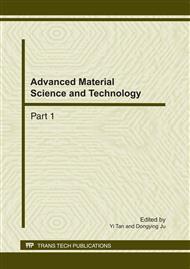p.155
p.159
p.163
p.167
p.171
p.175
p.179
p.183
p.189
Influence of La2O3 on the Electrical Properties of Dense SnO2 Electrodes
Abstract:
We prepared La2O3 doped SnO2 powder by a co-deposition method and used the doped material to manufacture tin dioxide electrodes by traditional ceramics methods.. The results showed that La2O3 led to an obvious decrease in electrical resistivity at room temperature but it had little influence at temperatures higher than 600 °C. The samples were characterized by X-ray diffraction and section scanning electron microscopy. We found that La2O3 increased the rate of tin dioxide crystal growth. At La2O3 concentrations as high as 1 wt%, a new La2Sn2O7 phase was present and this phase plays an important role in improving the electrical properties of the La2O3-doped SnO2.
Info:
Periodical:
Pages:
171-174
Citation:
Online since:
February 2011
Authors:
Price:
Сopyright:
© 2011 Trans Tech Publications Ltd. All Rights Reserved
Share:
Citation:


